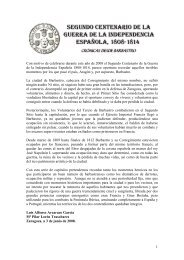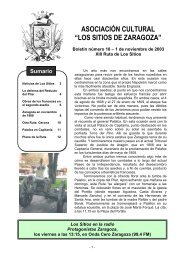Las Cinco Villas de Aragón durante la Guerra - Asociación Cultural ...
Las Cinco Villas de Aragón durante la Guerra - Asociación Cultural ...
Las Cinco Villas de Aragón durante la Guerra - Asociación Cultural ...
You also want an ePaper? Increase the reach of your titles
YUMPU automatically turns print PDFs into web optimized ePapers that Google loves.
Loison a Navarra para rec<strong>la</strong>mar los <strong>de</strong>stacamentos <strong>de</strong> su Tercer Cuerpo que tiene en<br />
esa región en lugar <strong>de</strong> combinar esfuerzos y <strong>de</strong>struir <strong>la</strong> partida <strong>de</strong> Mina.<br />
Pero Napoleón, que no está satisfecho con los asuntos <strong>de</strong> Navarra, el 17 <strong>de</strong><br />
diciembre, manda a Suchet que consi<strong>de</strong>re esa región bajo sus ór<strong>de</strong>nes, que supervise<br />
allí <strong>la</strong> administración imperial y envíe columnas móviles para pacificar<strong>la</strong> 240.<br />
FRACASA HARISPE CONTRA MINA<br />
Suchet, con <strong>la</strong> mayor parte <strong>de</strong> sus fuerzas en Teruel, encarga al general Harispe 241<br />
<strong>de</strong> <strong>la</strong>s operaciones en Navarra, y éste p<strong>la</strong>nea atrapar a Mina en Sangüesa por medio<br />
<strong>de</strong> tres columnas convergentes. Harispe, con un batallón, que más tar<strong>de</strong> sería reforzado<br />
con otros dos, avanzaría <strong>de</strong>s<strong>de</strong> Ejea hasta Sos. Un <strong>de</strong>stacamento <strong>de</strong> cuatrocientos<br />
po<strong>la</strong>cos <strong>de</strong>l 2º regimiento <strong>de</strong>l Vístu<strong>la</strong> <strong>de</strong>s<strong>de</strong> Tu<strong>de</strong><strong>la</strong> bajo el mando <strong>de</strong>l coronel<br />
Esteko avanzaría en dirección noreste a lo <strong>la</strong>rgo <strong>de</strong>l río <strong>Aragón</strong> hacia Sangüesa<br />
y el ex gobernador <strong>de</strong> Navarra D’Agoult apoyaría <strong>la</strong> operación enviando ciento<br />
ochenta hombres <strong>de</strong> infantería y cuarenta <strong>de</strong> caballería para evitar que Mina se retirase<br />
hacia Carrascal o Puente <strong>la</strong> Reina, advirtiendo D’Agoult a Harispe que <strong>de</strong>bería<br />
perseguir a <strong>la</strong> partida <strong>de</strong> Mina una vez que esta se hubiese dispersado, ya que si no,<br />
<strong>la</strong> operación fal<strong>la</strong>ría. Este complicado p<strong>la</strong>n, que suponía tres columnas ampliamente<br />
separadas, finalmente fracasó y Napoleón, el 28 <strong>de</strong> diciembre, repren<strong>de</strong> a Suchet<br />
por haber enviado fuerzas insuficientes a Navarra 242.<br />
NOTAS AL CAPÍTULO V<br />
<strong>Las</strong> <strong>Cinco</strong> <strong>Vil<strong>la</strong>s</strong> <strong>de</strong> <strong>Aragón</strong> <strong>durante</strong> <strong>la</strong> <strong>Guerra</strong> <strong>de</strong> In<strong>de</strong>pen<strong>de</strong>ncia Españo<strong>la</strong><br />
184 El término “policía” era amplísimo, no reduciéndose al mero or<strong>de</strong>n público.<br />
185 Bayod Pal<strong>la</strong>rés, Roberto: El Reino <strong>de</strong> <strong>Aragón</strong> <strong>durante</strong> el gobierno intruso <strong>de</strong> los Napoleón, Ed.<br />
Librería General, Zaragoza 1979, 72-74.<br />
186 Domínguez había sido el segundo firmante <strong>de</strong> <strong>la</strong> Representación hecha al rey José en Zaragoza el<br />
11 <strong>de</strong> marzo <strong>de</strong> 1809, un mes <strong>de</strong>spués <strong>de</strong> tomada <strong>la</strong> ciudad, y publicada en El Imparcial. Fue hombre<br />
<strong>de</strong> confianza <strong>de</strong> Suchet que hace su elogio en <strong>la</strong> Gaceta <strong>de</strong> Zaragoza n.º 24 <strong>de</strong>l 13 <strong>de</strong> julio <strong>de</strong> 1809.<br />
Gil Novales: 147.<br />
187 Domínguez, Menche y Quinto serán nombrados más a<strong>de</strong><strong>la</strong>nte miembros <strong>de</strong> <strong>la</strong> Legión <strong>de</strong> Honor por<br />
el buen trabajo que realizarán aprovisionando al ejército francés en el Sitio <strong>de</strong> Tortosa.<br />
188 AHGF: C8/25, C<strong>la</strong>rke a Junot, 1 <strong>de</strong> abril <strong>de</strong> 1809. Alexan<strong>de</strong>r, Don W.: Rod of Iron (French<br />
Counterinsurgency Policy in Aragon during the Peninsu<strong>la</strong>r War), Scho<strong>la</strong>rly Resources Inc.<br />
Wilmington, De<strong>la</strong>ware, USA 1985; 5 y 6 y Oman, Charles: A History of the Peninsu<strong>la</strong>r War,<br />
C<strong>la</strong>rendon Press, Oxford 1902-1930, II, 412. La or<strong>de</strong>n para <strong>la</strong> retirada fue emitida el 5 <strong>de</strong> abril <strong>de</strong> 1809<br />
y <strong>de</strong> <strong>la</strong> evacuación da cuenta <strong>la</strong> Gaceta <strong>de</strong>l Gobierno: “El 10 <strong>de</strong> abril llegó un posta <strong>de</strong>l ejército francés<br />
que estaba en Bellver con or<strong>de</strong>n <strong>de</strong> retirarse a Francia a marchas dobles y el 11 <strong>de</strong> madrugada<br />
141











